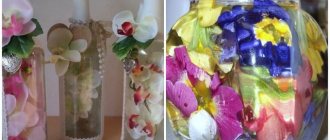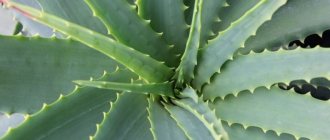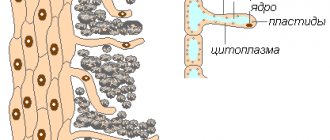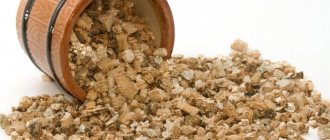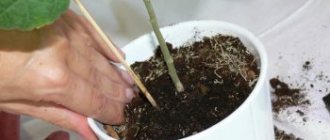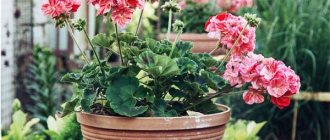We consider various methods of drying flowers: air, flat and volume drying, as well as quick methods (microwave, iron). We tell you how to properly dry flowers to preserve the color and shape of the petals.
Also see recommendations for collecting plants and flowers, advice from experienced florists and interesting facts.
Methods for drying plants and their flowers and leaves
Among flower connoisseurs and creators of crafts, jewelry or herbariums, time-tested methods are used.
To dry flowers or leaves, the following methods are effective: air, books and press, materials with high moisture absorption capacity, microwave and iron. As well as “preservation” in glycerin and paraffin.
View this post on Instagram
Publication from TOMATA - only the truth! GARDEN (@_olga_sherl_)
Is it possible to keep dried flowers at home?
The question is quite vague, as it affects several areas of life.
From an esoteric point of view, a herbarium is a treasure of energy that can give a person natural warmth. They improve immunity, maintain health and prolong life.
According to the teachings of Feng Shui, any cut plants bring withering and death, so it is not recommended to keep dried flowers at home.
There is an opinion among scientists that dry buds accumulate a lot of dust, which is difficult to remove from the surface, so keeping a herbarium in an apartment is contraindicated for asthmatics and allergy sufferers.
What are stabilized plants
In the 70s, the spouses Paul and Jeanette Lambert first tried to extend the life of a flower by replacing the composition of its cells. The technology was based on the processes that occur during embalming. The experiment was a success, and the world saw unfading buds
.
Stabilized flowers
- These are fresh plants in the cells of which water has been replaced with a preservative substance. It does not allow the flora to fade, the foliage and buds remain bright and flexible.
Unlike dried flowers, embalmed flowers do not fall off or break when touched. They retain a bright shade. You can safely move them or make a real bouquet out of them.
Collection rules
In order for flowers to retain their bright colors and last a long time, they need to be cut correctly. Also keep in mind that not all plants will look good when dry.
What flowers can be dried?
It is believed that the most popular flower for drying is the dark burgundy rose. However, experienced herbalists and flower growers know that not only this species is capable of maintaining color for a long time. Plants that are great for drying and retain color for a long time include:
- peonies;
- apricot blossom;
- marigold;
- pansies;
- forget-me-nots;
- daisies;
- muscari;
- lilac;
- yellow tulips;
- lilies;
- hydrangeas;
- gypsophila;
- echinacea;
- immortelle;
- delphinium;
- gomphrena spherical.
Lighten up a little:
- red tulips;
- roses with small pink buds;
- rose hip.
They don't retain color at all:
- carnations;
- periwinkle;
- Japanese quince;
- nettle;
- all types of violets.
Please note that poppy is the most fragile plant to dry.
When is the best time to cut flowers for drying?
The beauty and durability of a dry bouquet is determined by several basic criteria. When collecting plants, observe the following rules:
- cut flowers after lunch, when the dew has completely disappeared from their surface;
- For the procedure, use special garden shears;
- cut the stem at a distance of 2–3 cm from the ground;
- choose a plant with a bud that has not yet opened, otherwise the petals will fall off during the drying process.
Make sure that the plants do not have rotten or damaged leaves, stems or flowers.
Preparation
Before the drying process, properly prepare the future herbarium.
- Place the collected flowers on the surface and remove excess leaves and thorns.
- Pack the plants by variety and group them into bouquets of 10 pieces.
- Leave large species to dry separately.
- Attach wire to thin stems so as not to break the dried composition in the future.
- Secure the ends of the stems in the bouquet with an elastic band. Make sure that it does not sit too tightly, otherwise moisture will accumulate in the plants and it will rot.
In general, preparation takes very little time and does not require special skills.
Air drying + without hanging + in a vase with water
A very popular method, indispensable for large flowers and plants. Main advantages: lightness and simplicity.
For drying, you need a dark (without direct sunlight), dry and not too warm room with excellent ventilation (pantry, attic, garage, attic). Depending on the type and size of the plant, the drying process takes a different amount of time.
Flowers
- Cut flowering species as soon as the flowers open. Remove the bottom pair of leaves or all the leaves if you only want the flower itself.
- Tie the plants at the base of the stem, 5-10 pieces in a bunch. It is better to wrap every 2-3 stems, and at the end of the entire bouquet, with a rubber band (tourniquet, twine) so that the flowers do not fall apart after drying. Avoid excessive tension to prevent moisture from accumulating in the dressing areas.
- Hang the bunches with flowers, spikelets down, on a stretched rope (twine, wire, fishing line), no closer than 15 cm to the ceiling, with a 10-15 cm gap between each other, on hooks, paper clips, or secure with a clothespin. In a bunch, the leaves should be well ventilated, and the flowers should not touch each other.
- Leave the flowers hanging for 15-30 days, and if the petals are thick and dense or the conditions are not optimal, then for 35-40. When the flowers dry, the petals will be hard and fragile to the touch.
Cereals
Harvest a couple of days before flowering or after the spikelets turn a light straw color. After harvesting, trim the tips of the stems so that they are at the same level, and the tops of the spikelets, on the contrary, are at different heights. Further actions are similar.
Rules and tips
- It is better to link different types separately.
- It is better to dry large flowers one at a time (hydrangea, peony, rose (thorns must be removed), lilac).
What flowers can be dried?
The air method is easy to dry ornamental grasses or spikelets of cereal species (rye, wheat, barley, etc.), as well as medicinal or beneficial species (St. John's wort, mint, thyme, sage, etc.).
Cornflower, hydrangea , decorative onions, poppy, rose, lilac (cut immediately after the lower flowers bloom), physalis.
This method is not suitable for flowers with delicate and thin petals (narcissus, peony).
Air drying of flowers and plants
Air dry without hanging
If it is not possible to hang the plants, then they can be wrapped in blotting paper or rice napkins and placed on top of cardboard or in boxes. Flowers usually dry in 14-20 days.
This method is suitable for the following plants: ammobium, periwinkle, heather, gypsophila, goldenrod, kermek (statice), lavender, echinopsis and others.
Drying in a vase with water
Some plants wither faster than you can dry them. Therefore, a combined method is used for them: water + air drying.
- Pour 4-5 cm (no more!) of water into the vase and place the flowers (bottom cut diagonally). As the water evaporates, the plants will dry out.
- After the buds have wilted a little, remove the flowers and trim the ends of the stems that were in the water to prevent mold. Then dry the plants by laying them horizontally on cardboard or paper.
Plants
A convenient method for such plants: globular artichoke, heather, carnation (after the flower has fully bloomed), gypsophila, hydrangea, lavender, bulbous, yarrow, chicory, etc.
How to dry flowers for decoration
To add coziness to your home or decorate a room for a celebration, it is not necessary to resort to the services of florists. You can dry flower arrangements yourself and use them as unique decorations. The drying procedure can be carried out in several ways.
Hanging drying flowers
The simplest and most cost-effective method. To do this, you will need a dry, dark and well-ventilated room, as well as tools for hanging bouquets, such as hooks or nails.
To make you happy with the result:
- maintain the room temperature from +10 to +18 degrees;
- hang bouquets at a distance from each other, 20 cm below the ceiling;
- wait until the compositions are completely dry (this usually takes 2-3 weeks);
- Cover the finished herbarium with hairspray to secure it.
Drying flowers in the microwave
Drying flowers in the microwave is simple, effective, and most importantly fast. It is surprising that when dried in this way, the buds do not lose color or shape at all. To dry, you will need silica gel or crystal cat litter.
- Pour some silica gel into a microwave-safe container.
- Place the plant on it and carefully add another portion of the substance.
- Place the container in the microwave and press start, setting the timer for 1-2 minutes.
- Check the condition of the bud every 30 seconds.
- When the flower is completely dry, remove the container from the oven and let it cool without removing it from the filler.
How to dry flowers in semolina
Semolina absorbs liquid well, so it is ideal for drying plants.
Procedure:
- Place a layer of semolina 1.5-2 cm thick at the bottom of the container.
- Place flowers with large buds head down, and those with elongated buds head up.
- Cover the plants completely with semolina.
- Do not cover the container with a lid and set it to dry in a well-ventilated place.
- In 5–14 days the herbarium will be ready.
How to dry flowers in salt
It is best to dry small flowers in salt, such as chamomile, bells or rose hips. Fine “Extra” salt is perfect for this procedure.
Step by step guide:
- Select a container that matches the size of the bud; if it is too large, more salt will be needed and the possibility of damaging the integrity of the flower will increase.
- Add a small layer of salt to the bottom and place the plants on it.
- Gently sprinkle the rest of the salt on top.
- Keep the plant in salt for 30–35 days, checking its condition periodically.
Press drying flowers
The good thing about this method is that you can dry a large number of bouquets at one time. Ready-made compositions are great for placement in panels. For the procedure you will need paper napkins, 2 sheets of plywood, and a weight.
Action plan:
- Wrap each plant in a napkin.
- Place the finished flowers on one sheet of plywood.
- Cover the workpieces with a second sheet and press down with a weight.
- Once a day, replace the paper that has absorbed moisture from the plants with new one.
- After 5–7 days, remove the finished bouquets and use them for their intended purpose.
Using an iron
This method is suitable for drying small flowers with flat buds. Using an iron you can dry clematis, pansies or primrose. For the procedure, you will need a paper napkin or tissue paper.
Action plan:
- Place the flower between two sheets of paper.
- Iron the surface thoroughly.
- When the paper gets wet, replace the sheet with a new one.
- Evaporate the moisture from the plant until it is completely dry.
Drying flowers in a convection oven
The convection function in the oven will help you quickly dry any type of plant. For the procedure you will also need a wire mesh with small cells.
Step by step guide:
- Place the mesh on the oven rack.
- Stick one flower into each cell so that they are in a vertical position.
- Place the grill in an oven already preheated to 38–40 degrees.
- After 7–8 hours, remove the pieces from the oven and cool.
Please note that you cannot use a conventional oven in this way.
Drying flowers by immersion in desiccant
This method is suitable for drying flowers with large buds. As a desiccant, you can choose any material that absorbs moisture well. Silica gel, cat litter or borax with flour (in proportions 1:6) are suitable.
Scheme of work:
- Add a small layer of desiccant to the container.
- If desired, add a little salt at the rate of 15 g of salt per 1 liter of substance. This will help preserve the richness of the bud.
- Place the flowers in a container and cover with a layer of desiccant.
- Please note that if you are using borax, you do not need to close the lid of the container. Otherwise, close the container tightly.
- Wait for the plants to dry. On average, drying takes 3-5 days when using silica gel or cat litter, and 10 to 14 days when using borax.
Sand and cotton wool
Such materials absorb moisture well, so they are excellent for drying flower arrangements. However, this method has a slight drawback - you can only use buds without a stem.
Prepare the sand in advance: rinse in water, bake in the oven and sift through a sieve. It must be perfectly clean and dry.
Cotton wool can be used immediately for the procedure.
Action plan:
- Pour some sand into a cardboard box or line the bottom with cotton wool.
- Place the buds on a layer so that they do not touch each other.
- Gently sprinkle the flowers with sand or cover with cotton wool.
- Leave the plants to dry for about 2-3 weeks.
- During the drying process, check the condition of the buds and add filler if necessary.
As a result, the petals become like paper and do not break when touched.
Paraffin method
Using paraffin, you can create unique compositions that closely resemble natural bouquets.
The method is quite labor-intensive. Melt the paraffin and carefully apply it to each petal using a brush. Let the flower dry.
Glycerin preservation
Using glycerin you can create original dried “wet” flowers. The method is only suitable for preserving buds.
Operating procedure:
- Mix glycerin with hot water in a 1:2 ratio.
- Place the buds in an airtight container and fill with the glycerin mixture.
- Close the container tightly with a lid.
- After 2-3 days, remove the compositions from the solution and blot with a paper towel.
As a result, you will get original elastic and shiny buds.
Using glycerin you can create a unique design object. Place 1 flower or small arrangement in a beautiful jar and fill with glycerin. Close the container tightly and decorate to your liking.
Quick drying
If you need to dry the flowers quickly, use a conventional oven. To do this, preheat the oven to 60 degrees and leave the plants in it for 60 minutes. Keep the oven door open during drying. At the end of the procedure, let the bouquets cool and use for their intended purpose.
Dry flowers
A method for the lazy
For particularly lazy beauty lovers, there is a way to dry flowers that does not require much effort. Hydrangea, for example, is ideal for this purpose. Cut the hydrangea stem along with the bud to the length required. It is worth cutting when the petals feel like paper to the touch.
Place the stems in a vase with a little water and wait for the water to evaporate. At first it may seem that the flower is losing its original beauty, but do not forget that it dries out, and it is normal that it changes shape and color. A few weeks later, use them as decoration, or simply leave them in a vase.
Dry under pressure
It is necessary to warn that this method is not suitable for drying flowers with voluminous buds, if you want to maintain their shape - they will simply become flat. The ideal choice would be daisies, dandelions, carnations and other flowers that do not deform greatly under pressure, but the final decision is yours.
In order to dry flowers under pressure and preserve their beauty, collect healthy plants without stains or damage. It is best to cut them on a sunny day, if there has been no rain for some time, so that drops of water or dew do not remain on the petals.
Cover the flower with parchment paper or baking paper and place it face down in a thick, heavy book. It is advisable that this be a telephone directory. After this, leave the flower under pressure for 7-10 days, sometimes checking the result if desired.
Which method should I choose to ensure that the flowers retain their shape?
To ensure that flowers retain their shape and can be placed in a vase as fresh, use techniques for drying that have minimal impact on the integrity of the plants.
Air drying is considered the best way, since no pressure is applied to the bud.
You can also use drying methods in bulk solids, but you must be very careful when doing this.
Paraffin or glycerin will help preserve the shape, and even the original color and shine of the plant.
Flowers as a gift
Dry with silica gel
This method is ideal for drying large, whole flowers. Initially, salt and sand were used for traditional drying. However, these materials are more difficult to clean, the process takes 6 to 8 weeks, and the results are always unpredictable.
Nowadays, instead of sand and salt, silica gel is used - transparent or white crystals, sometimes with blue splashes. It allows you to dry a flower in a few days, preserving its original color and shape as much as possible. Often, plants dried with silica gel look almost exactly like freshly picked ones.
The silica gel absorbs the liquid from the plant and the blue crystals turn pink, signaling that it has released as much liquid as possible. The process must take place in an airtight container.
In addition, silica gel can be reused - to do this, you just need to dry it thoroughly. To do this, the used crystals must be placed on a baking sheet and placed in an oven preheated to 210 degrees Celsius. Once the crystals turn blue again, they can be reused.
How to dry flowers for epoxy resin
By filling flowers with epoxy resin, you can end up with an original glazed decoration with a glossy surface. Petals or buds are completely dipped in the substance or covered with a thin layer using a brush.
In order for the product to turn out neat, the flowers must be even and completely dry, otherwise they will lose their color over time.
For bulk drying, desiccant or semolina is best. If the flower has different thicknesses of petals, dry the bud only in cotton wool.
Third way
The third way is to dip the leaves in melted wax (or paraffin). I chose this option. I think it is better to save the leaves this way for shipping. Then they will not be as fragile as dried ones. I couldn’t melt the candle in the microwave, and it would have been inconvenient to heat it up every time, so I used a regular stove.
When the wax becomes liquid, dip the leaf into it and turn it over so that the wax covers it on both sides.
Then carefully remove, allowing excess paraffin to drain. Place it on newspaper so that the leaf dries and hardens.
Here it is necessary to select an average temperature so that the paraffin does not boil (otherwise the leaves will lose color),
but it didn’t thicken either, because then the layer of wax turns out to be too thick:
A fun activity :). And drops of wax from the stove are easy to remove later.
At the same time, I decided to preserve rowan berries in this way:
See also: Crafts from vegetables and fruits (160 photos)
From these leaves and berries we made a craft for the kindergarten - the application “Autumn Round Dance” (two teachers, a nanny and children :)):
How to dry flowers from Matrona of Moscow
It is believed that flowers from Matrona of Moscow have miraculous powers. They are usually dried and:
- used as home amulets;
- make tea;
- applied to sore spots on the body;
- used for rituals and worship.
Rose buds brought from Matrona of Moscow are best dried in a suspended state in a well-ventilated area. However, it makes no difference which drying method is chosen, the main thing is to preserve the bouquet and believe in its unique power.
When to cut hydrangea flowers to dry?
Blue (purple) hydrangea.
The ideal time for cutting hydrangea flowers is the end of flowering, when the juice leaves the inflorescences, the end of September - the beginning of October. Autumn pruning of hydrangea here.
On a note! If you cut too early, the sepals will wilt.
Cut branches of flowering hydrangea on a sunny, dry day, leaving 10-11 cm of stem.
On a sunny, dry day, remove the hydrangea branches, leaving four inches of stem. Cut the stem slightly above the new buds so as not to damage them and preserve them for future flowering.
Make the cut just above the new buds.
Remove leaves to reduce evaporation and improve shelf life. We also recommend removing any damaged flowers.
Features of drying different types of flowers
For the drying procedure to be effective, please note that some varieties of flowers should only be dried in a certain way, as well as properly prepared. For example:
- Before drying, hold roses over steam for 15–20 minutes;
- to preserve small lilac flowers, use semolina, lowering the branch with the buds down, or put them under a press;
- It is better to dry bird cherry in separate branches, so they dry faster;
- Jasmine petals are very fragile and delicate, so they can only be dried naturally, without heat treatment;
- White apple buds may turn brown after drying, so choose pink varieties.
First way
The first traditional way to preserve leaves is to dry them between sheets of newspaper or books, placing something heavy on top. More suitable for leaves in small quantities or small sizes. Because we have nowhere to place so many stacks of newspapers with books (enough for four people)
